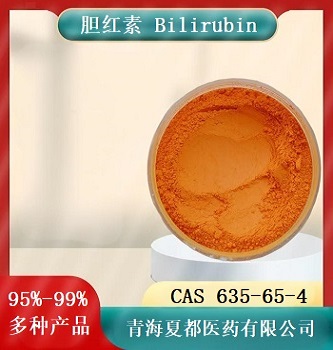1. Basic Information
- Chemical Name: Bilirubin (also known as Cholepyrrhin, Bile Scarlet).
- CAS No.: 635-65-4.
- Molecular Formula: C33H36N4O6; Molecular Weight: 584.66.
- Source:
- Primarily derived from hemoglobin metabolism in senescent erythrocytes.
- Extracted from bile via complex industrial processes.
2. Physicochemical Properties
- Appearance: Reddish-brown or orange-yellow crystalline powder, odorless and tasteless.
- Solubility:
- Practically insoluble in water.
- Slightly soluble in ethanol and ether.
- Freely soluble in benzene, chloroform, carbon disulfide, and hot ethanol-chloroform mixtures.
- Sodium salt: water-soluble; calcium/magnesium salts: insoluble.
- Stability:
- Stable as a dry solid; chloroform solutions remain stable when protected from light.
- Oxidizes to biliverdin in the presence of strong alkalies or ferric ions.
3. Pharmacological Effects
- Antioxidant:
- Inhibits lipid peroxidation, protects cell membrane phospholipids from free radical damage, and delays atherosclerosis.
- Antitumor:
- Suppresses W256 carcinoma growth with a higher inhibition rate than cholic acid and deoxycholic acid.
- Hepatoprotective:
- Promotes hepatocyte proliferation; used in treating hepatitis, cirrhosis, and other liver diseases.
- Antiviral:
- Exhibits significant inactivation activity against Japanese encephalitis virus.
- Additional Effects:
- Sedative, antipyretic, antihypertensive properties; stimulates erythrocyte regeneration.
4. Applications
- Pharmaceuticals:
- Raw material for drug formulations.
- Key component of artificial bezoar for hepatobiliary disease treatment.
- Biochemical reagent for antibody preparation and immunoassays (e.g., ELISA).
- Food Industry:
- Natural pigment additive in meat products, beverages, and confectionery.
- Industrial & Chemical:
- Used in dyes, pigments, and latex paint production.
5. Production & Supply
- Primary Manufacturer: Qinghai Xiadu Pharmaceutical Co., Ltd. (supplies API).
6. Precautions
- Toxicity: Toxic at high concentrations; dosage must be strictly controlled.
- Storage: Preserve below -20°C in light-resistant containers; avoid repeated freeze-thaw cycles.
- Contraindications:
- Incompatible with strong oxidizing agents.
- Use with caution in patients with hepatic insufficiency.
